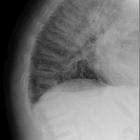Chronic renal disease
Chronic kidney disease (CKD), also known as chronic renal failure, is a progressive loss of glomerular function caused by a long-standing renal parenchymal disease. It is present when the glomerular filtration rate (GFR) is less than 60 ml/min/1.73 m for three consecutive months or greater than or equal to this value in patients with a kidney damage that is present for three or more months .
Epidemiology
CKD is a prevalent disease, affecting between 10-15% of the adult population globally .
Clinical presentation
Clinical presentation depends a lot on etiology. Children with chronic kidney disease can have growth disorder, edema and cola colored urine (due to RBC casts). Adults can have non-specific symptoms like nausea, vomiting, weight loss, and easy fatigability. Hypertension is common in adults with chronic kidney disease.
Pathology
A variety of different diseases can affect and cause damage to the renal parenchyma, the most common are :
- diabetes mellitus (diabetic nephropathy)
- hypertension
- glomerulonephritis
- polycystic kidney disease
Classification
Chronic kidney disease can be classified in a variety of ways. One such classification, proposed in 2005, can be divided into five stages based on the GFR (ml/min/1.73 m) :
- stage 1: >90: kidney damage with normal or elevated GFR
- stage 2: 60-89: kidney damage with mild reduction in GFR
- stage 3: 30-59: moderate reduction in GFR, this can be further sub divided as
- stage 3a: 59-45
- stage 3b: 44-30
- stage 4: 15-29: severe reduction in GFR
- stage 5: <15 (or dialysis): end-stage kidney disease (ESKD)
The same publication suggests that chronic kidney disease can also be broadly classified by treatment type:
- kidney transplant recipient
- CKD independent of dialysis
- CKD on dialysis
Contrast agents
Gadolinium contrast has been associated with nephrogenic systemic fibrosis (NSF) in the setting of chronic kidney disease. The threshold that is a contraindication for administration of gadolinium contrast is institution dependent and also depends on the dose and type of contrast agent being used, but a GFR of 20-30 ml/min is considered a contraindication and a GFR of 30-60 ml/min usually necessitates a smaller dose. Dialysis is a contraindication.
Radiographic features
There are no specific imaging features for CKD, and the diagnosis is based on clinical and laboratory findings. Radiological exams, especially ultrasound, are performed in most of the cases for etiological investigation (e.g. renal artery stenosis, polycystic kidney disease, hydronephrosis) and treatment follow-up.
Ultrasound
Ultrasound with Doppler examination of intrarenal vessels is usually performed in patients with CKD, and it is common to have a normal exam.
Typical B-mode findings of a long-standing severe CKD (especially stage 5) are :
- reduced renal cortical thickness <6 mm
- more reliable than length
- reduced renal length
- increased renal cortical echogenicity
- poor visibility of the renal pyramids and the renal sinus
- marginal irregularities
- papillary calcifications
- cysts (see also: acquired cystic kidney disease)
Abnormal Doppler findings in these patients are :
- reduced renal vascularity
- increased resistance index (RI) values (segmental and interlobular arteries)
Treatment and prognosis
Stage 3 CKD patients are reported to be 20 times more likely to die of a cardiovascular event than to reach end-stage renal disease . The chronic vascular disease is a common CKD associated complication and deserves particular attention . An extensive study evidenced that treatment and prevention of coronary artery disease, congestive heart failure, diabetes mellitus, and anemia should be the target treatment to reduce the mortality of patients with CKD .
Siehe auch:
und weiter:
 Assoziationen und Differentialdiagnosen zu chronische Niereninsuffizienz:
Assoziationen und Differentialdiagnosen zu chronische Niereninsuffizienz:





